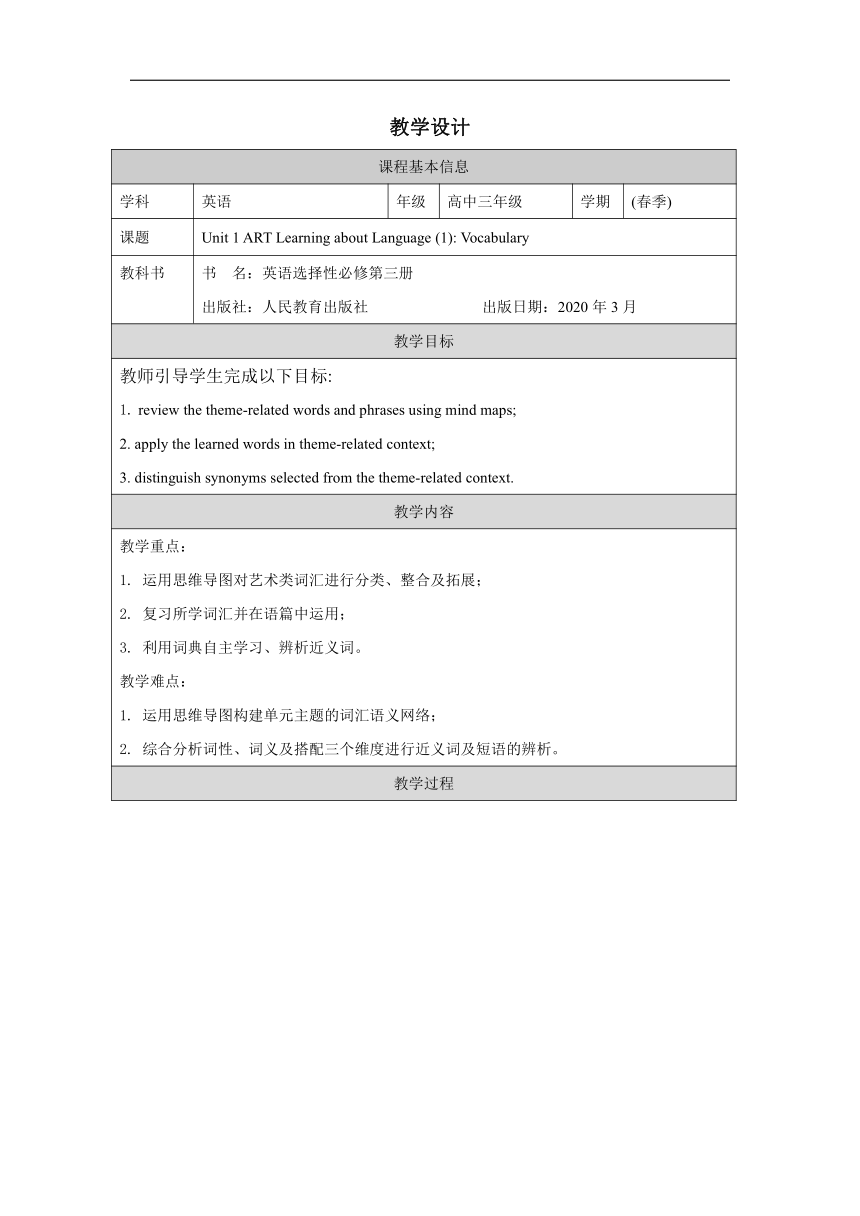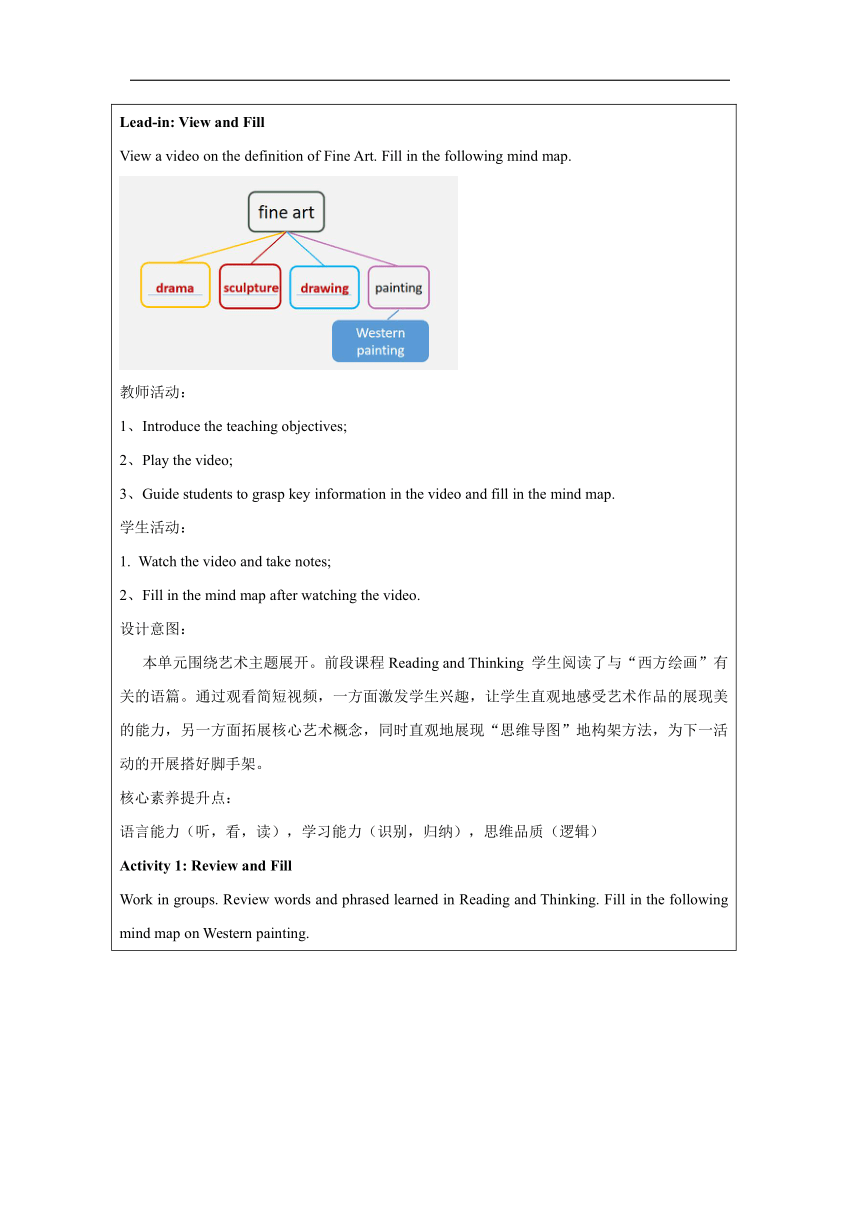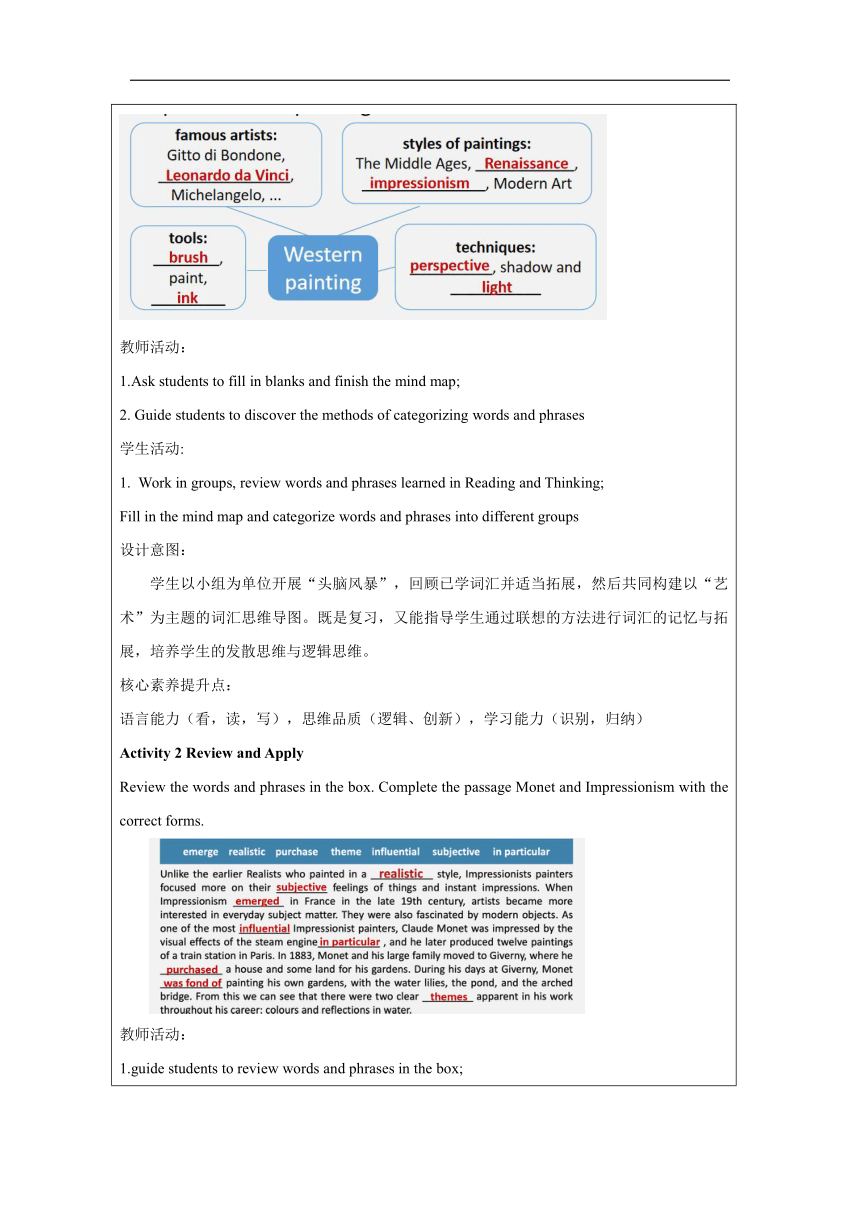Unit 1 ART Learning about Language (2) Vocabulary教学设计(表格式)
文档属性
| 名称 | Unit 1 ART Learning about Language (2) Vocabulary教学设计(表格式) |  | |
| 格式 | docx | ||
| 文件大小 | 349.2KB | ||
| 资源类型 | 教案 | ||
| 版本资源 | 人教版(2019) | ||
| 科目 | 英语 | ||
| 更新时间 | 2024-05-08 14:02:28 | ||
图片预览



文档简介
教学设计
课程基本信息
学科 英语 年级 高中三年级 学期 (春季)
课题 Unit 1 ART Learning about Language (1): Vocabulary
教科书 书 名:英语选择性必修第三册 出版社:人民教育出版社 出版日期:2020年3月
教学目标
教师引导学生完成以下目标: 1. review the theme-related words and phrases using mind maps; 2. apply the learned words in theme-related context; 3. distinguish synonyms selected from the theme-related context.
教学内容
教学重点: 运用思维导图对艺术类词汇进行分类、整合及拓展; 复习所学词汇并在语篇中运用; 利用词典自主学习、辨析近义词。
教学难点: 运用思维导图构建单元主题的词汇语义网络;
2. 综合分析词性、词义及搭配三个维度进行近义词及短语的辨析。
教学过程
Lead-in: View and Fill View a video on the definition of Fine Art. Fill in the following mind map. 教师活动: 1、Introduce the teaching objectives; 2、Play the video; 3、Guide students to grasp key information in the video and fill in the mind map. 学生活动: Watch the video and take notes; 2、Fill in the mind map after watching the video. 设计意图: 本单元围绕艺术主题展开。前段课程Reading and Thinking 学生阅读了与“西方绘画”有关的语篇。通过观看简短视频,一方面激发学生兴趣,让学生直观地感受艺术作品的展现美的能力,另一方面拓展核心艺术概念,同时直观地展现“思维导图”地构架方法,为下一活动的开展搭好脚手架。 核心素养提升点: 语言能力(听,看,读),学习能力(识别,归纳),思维品质(逻辑) Activity 1: Review and Fill Work in groups. Review words and phrased learned in Reading and Thinking. Fill in the following mind map on Western painting. 教师活动: 1.Ask students to fill in blanks and finish the mind map; 2. Guide students to discover the methods of categorizing words and phrases 学生活动: Work in groups, review words and phrases learned in Reading and Thinking; Fill in the mind map and categorize words and phrases into different groups 设计意图: 学生以小组为单位开展“头脑风暴”,回顾已学词汇并适当拓展,然后共同构建以“艺术”为主题的词汇思维导图。既是复习,又能指导学生通过联想的方法进行词汇的记忆与拓展,培养学生的发散思维与逻辑思维。 核心素养提升点: 语言能力(看,读,写),思维品质(逻辑、创新),学习能力(识别,归纳) Activity 2 Review and Apply Review the words and phrases in the plete the passage Monet and Impressionism with the correct forms. 教师活动: 1.guide students to review words and phrases in the box; 2.Make a demonstration, analyze the context of the first missing words, and ask students to check the part of speech, plural and singular forms of nouns and verb forms 3.Check answers in class. Solve problems if students make mistakes. 学生活动: 1.Review words and phrases learned in Reading and Thinking; 2.Complete the passage with the correct forms of words and phrases; 3.Give feedback while the teacher shares the answers. 设计意图: 活动二中的短文,简要介绍了艺术派的作品特点及该流派著名画家莫奈的创作主题,帮助学生拓展了艺术相关的知识与背景,巩固语篇知识,增强语篇意识。同时,活动要求学生在完全理解习得的单词短语的基础上,理解短文并填空,训练学生在相对复杂的语境中运用词汇的能力。 核心素养提升点: 语言能力(读,写),学习能力(识别,分析) Activity 3:Distinguish synonyms In a theme-related context, there may appear words or phrases with similar meanings. It is vital to have handy approaches to distinguish their differences in order to apply them properly in the context. 教师活动: Demonstration: take a group of words as the example, 1.Analyse the synonyms in three aspects: part of speech, meanings, collocations; 2.Create a blank-filling activity to check students understanding of this group of words. 学生活动: 1.Look up three words in the dictionary: realistic, practical, actual, and try to find their differences; 2.Fill in the blanks and check understanding. 设计意图: 在语篇中准确地应用词汇,要求学生准确理解这些词汇。尤其是一些中文意思非常接近的词语的辨析,要求学生从多个维度深度理解词汇,并熟练使用的英英词典进行自主学习。活动选择了前文语篇中的一些词汇,并给出近义词,老师指导学生如何辨析近义词,同时激发学生的思辨能力,并为下一步的学生小组活动搭好脚手架 核心素养提升点: 语言能力(看,读,写),学习能力(识别,分析,归纳),思维品质(逻辑、批判) Activity 4: Distinguish synonyms Work in groups. Look up each group of words and phrases in the dictionary and discuss their differences. Then create your blank-filling activity based on your understanding of these words. (one sentence for one word/ phrase). 教师活动: 1.Give instructions and guide students to work in groups to create blank-filling activities; ( for some students, send them a link to create blank-filling activities on the padlet.) 2.Organize the class: ask students to exchange their activities in turn; 3.Give class feedback. 学生活动: 1.Working in groups, students look up words and phrases in the dictionary, and find out the differences; 2.create blank-filling activities; 3.Exchange blank-filling activities with other classmates; 4.Discuss and check the answers; give feedback to other students. 设计意图 脚手架搭好后,学生通过这一活动,以小组为单位开展自主学习。即让学生在讨论中相互启发,相互学习,同时引导学生准确地理解词汇并直观地构建词汇辨析的方法,并对这些近义词加以有效地应用。通过自主学习,学生建立课堂主人翁意识,建立学习自信心。 核心素养提升点: 语言能力(读,写),学习能力(识别,分析,归纳),思维品质(逻辑、批判、创新) Homework: 1. Finish exercises 1 &3 on page 61 (required) 2. Write a short article to describe a piece of Chinese artwork. Make sure you use at least 10 words and phrases learned in this section. (optional) (文化意识培养)
课程基本信息
学科 英语 年级 高中三年级 学期 (春季)
课题 Unit 1 ART Learning about Language (1): Vocabulary
教科书 书 名:英语选择性必修第三册 出版社:人民教育出版社 出版日期:2020年3月
教学目标
教师引导学生完成以下目标: 1. review the theme-related words and phrases using mind maps; 2. apply the learned words in theme-related context; 3. distinguish synonyms selected from the theme-related context.
教学内容
教学重点: 运用思维导图对艺术类词汇进行分类、整合及拓展; 复习所学词汇并在语篇中运用; 利用词典自主学习、辨析近义词。
教学难点: 运用思维导图构建单元主题的词汇语义网络;
2. 综合分析词性、词义及搭配三个维度进行近义词及短语的辨析。
教学过程
Lead-in: View and Fill View a video on the definition of Fine Art. Fill in the following mind map. 教师活动: 1、Introduce the teaching objectives; 2、Play the video; 3、Guide students to grasp key information in the video and fill in the mind map. 学生活动: Watch the video and take notes; 2、Fill in the mind map after watching the video. 设计意图: 本单元围绕艺术主题展开。前段课程Reading and Thinking 学生阅读了与“西方绘画”有关的语篇。通过观看简短视频,一方面激发学生兴趣,让学生直观地感受艺术作品的展现美的能力,另一方面拓展核心艺术概念,同时直观地展现“思维导图”地构架方法,为下一活动的开展搭好脚手架。 核心素养提升点: 语言能力(听,看,读),学习能力(识别,归纳),思维品质(逻辑) Activity 1: Review and Fill Work in groups. Review words and phrased learned in Reading and Thinking. Fill in the following mind map on Western painting. 教师活动: 1.Ask students to fill in blanks and finish the mind map; 2. Guide students to discover the methods of categorizing words and phrases 学生活动: Work in groups, review words and phrases learned in Reading and Thinking; Fill in the mind map and categorize words and phrases into different groups 设计意图: 学生以小组为单位开展“头脑风暴”,回顾已学词汇并适当拓展,然后共同构建以“艺术”为主题的词汇思维导图。既是复习,又能指导学生通过联想的方法进行词汇的记忆与拓展,培养学生的发散思维与逻辑思维。 核心素养提升点: 语言能力(看,读,写),思维品质(逻辑、创新),学习能力(识别,归纳) Activity 2 Review and Apply Review the words and phrases in the plete the passage Monet and Impressionism with the correct forms. 教师活动: 1.guide students to review words and phrases in the box; 2.Make a demonstration, analyze the context of the first missing words, and ask students to check the part of speech, plural and singular forms of nouns and verb forms 3.Check answers in class. Solve problems if students make mistakes. 学生活动: 1.Review words and phrases learned in Reading and Thinking; 2.Complete the passage with the correct forms of words and phrases; 3.Give feedback while the teacher shares the answers. 设计意图: 活动二中的短文,简要介绍了艺术派的作品特点及该流派著名画家莫奈的创作主题,帮助学生拓展了艺术相关的知识与背景,巩固语篇知识,增强语篇意识。同时,活动要求学生在完全理解习得的单词短语的基础上,理解短文并填空,训练学生在相对复杂的语境中运用词汇的能力。 核心素养提升点: 语言能力(读,写),学习能力(识别,分析) Activity 3:Distinguish synonyms In a theme-related context, there may appear words or phrases with similar meanings. It is vital to have handy approaches to distinguish their differences in order to apply them properly in the context. 教师活动: Demonstration: take a group of words as the example, 1.Analyse the synonyms in three aspects: part of speech, meanings, collocations; 2.Create a blank-filling activity to check students understanding of this group of words. 学生活动: 1.Look up three words in the dictionary: realistic, practical, actual, and try to find their differences; 2.Fill in the blanks and check understanding. 设计意图: 在语篇中准确地应用词汇,要求学生准确理解这些词汇。尤其是一些中文意思非常接近的词语的辨析,要求学生从多个维度深度理解词汇,并熟练使用的英英词典进行自主学习。活动选择了前文语篇中的一些词汇,并给出近义词,老师指导学生如何辨析近义词,同时激发学生的思辨能力,并为下一步的学生小组活动搭好脚手架 核心素养提升点: 语言能力(看,读,写),学习能力(识别,分析,归纳),思维品质(逻辑、批判) Activity 4: Distinguish synonyms Work in groups. Look up each group of words and phrases in the dictionary and discuss their differences. Then create your blank-filling activity based on your understanding of these words. (one sentence for one word/ phrase). 教师活动: 1.Give instructions and guide students to work in groups to create blank-filling activities; ( for some students, send them a link to create blank-filling activities on the padlet.) 2.Organize the class: ask students to exchange their activities in turn; 3.Give class feedback. 学生活动: 1.Working in groups, students look up words and phrases in the dictionary, and find out the differences; 2.create blank-filling activities; 3.Exchange blank-filling activities with other classmates; 4.Discuss and check the answers; give feedback to other students. 设计意图 脚手架搭好后,学生通过这一活动,以小组为单位开展自主学习。即让学生在讨论中相互启发,相互学习,同时引导学生准确地理解词汇并直观地构建词汇辨析的方法,并对这些近义词加以有效地应用。通过自主学习,学生建立课堂主人翁意识,建立学习自信心。 核心素养提升点: 语言能力(读,写),学习能力(识别,分析,归纳),思维品质(逻辑、批判、创新) Homework: 1. Finish exercises 1 &3 on page 61 (required) 2. Write a short article to describe a piece of Chinese artwork. Make sure you use at least 10 words and phrases learned in this section. (optional) (文化意识培养)
